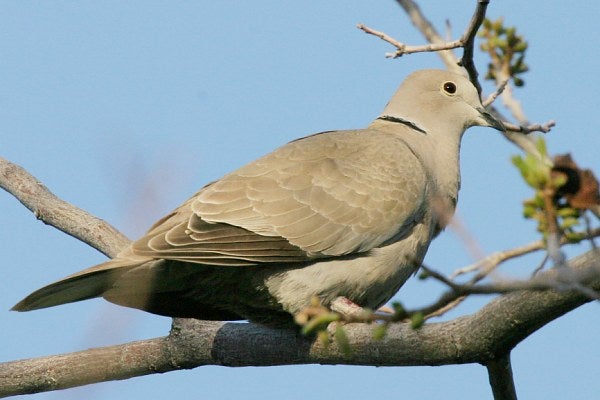New Dove Wings into America
Bob McNally 08.22.15

There’s a new target darting into America’s dove fields, and it looks as if it’s here to stay, much to the delight of many wingshooters.
The Eurasian collared dove (Streptopelia decaocto) is slightly larger than a mourning dove, roughly the size of a barnyard pigeon, and flying in much the same way. It doesn’t dive and dart as much as a mourning dove, flying more like a high-flying pigeon.
The collared dove is a slightly lighter gray color than a mourning dove, and it has a distinctive dark band around the back of the neck, thus it’s collared dove name.
There’s no mistaking it for a mourning dove or barnyard pigeon, and it’s a good bet more and more hunters will be seeing collared birds, since this non-native species is booming in population.
It was introduced to the Bahamas in 1974, and it’s believed hurricanes and strong winds brought them to South Florida by 1980.
Collared doves were not formally identified in Florida until 1986, at which time a population of about 10,000 birds were believed to have established in the Miami area and the Florida Keys. Five years later, in only Dade (Miami) and Monroe Counties, the population had swelled to an estimated 100,000, and colonies of birds were blossoming throughout Florida as well as in adjoining states.
One pair of collared doves may raise up to six broods of two squabs each per year. They are aggressive nesters and thrive in rural and suburban settings. Already they are in abundant supply throughout Florida and the entire Gulf Coast, including nearly all Texas counties. Large, huntable numbers of birds are available in Florida, Alabama, Mississippi, Arkansas, Louisiana, Texas, Georgia, and South Carolina.
Collared doves are extremely hardy and have been documented living above the Arctic Circle in Scandinavia, and verified sightings already have been made as far north as eastern Long Island, New York, and Cape May, New Jersey.
Because of their larger size, collared doves are tougher to bring down for hunters than mourning doves, with 7 1/2 shot preferred.
The larger birds are delicious on the table, tasting much like a mourning dove. In most states where collared doves are seen by mourning dove hunters, there are no restrictions on collared dove harvest. Moreover, the take of collared doves usually does not count against a mourning dove hunter’s limit. Check state regulations, however, before hunting collared doves.